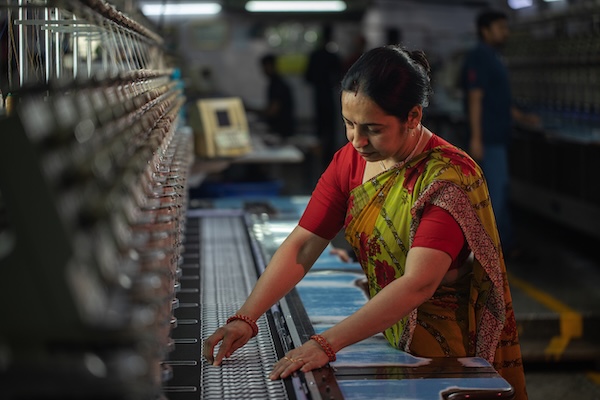.png)

Rajesh is an Assistant Professor IMS, Ghaziabad. His interests include monetary policy, financial markets, and macroeconomic frameworks. He writes with a monetarist’s lens.
August 20, 2025 at 10:18 AM IST
In the world’s shifting trade tapestry, Asia’s textile sector is both the anchor and the frontier. For decades, China’s ascent after WTO accession in 2001 defined the geography of global garment production. By 2010, it commanded over a third of world clothing exports, its vertically-integrated supply chain setting the benchmark for cost, speed, and scale. But dominance breeds dependency, and dependency invites risk.
Over the past five years, rising wages in China, Western import bans on Xinjiang cotton, and successive rounds of US Section 301 tariffs have accelerated a quiet but decisive shift — buyers and brands are reweaving their sourcing maps, and a cluster of Asian nations is stepping into the loom.
Bangladesh, Vietnam, India, and smaller players like Cambodia and Sri Lanka have steadily gained market share. WTO data show China’s share of global clothing exports fell to 31.6% in 2023, while Bangladesh reached 7.4% with $38.4 billion in exports, and Vietnam 6.09% with $33.94 billion. India’s apparel exports crossed $15 billion.
Together, these emerging Asian producers already account for nearly a sixth of world supply. The early months of 2025 have reinforced the trend: Vietnam’s garment exports rose 10% year-on-year in the first half of 2025 to nearly $22 billion; Bangladesh’s apparel sector earned $50 billion in 2024 and continues to grow; India’s garment exports were up 11.3% in May 2025 alone. Cambodia’s garment exports jumped 26.3% in the first two months of 2025, now comprising almost 39% of its total exports.
Yet the story is not simply one of China’s decline and others’ rise. The uncomfortable truth is that much of Asia’s new growth still runs through Chinese yarns, fabrics, and machinery. Vietnam sources about 65% of its textile inputs from China; Bangladesh and Cambodia have similar dependencies. When Western customs authorities step up enforcement, as under the Uyghur Forced Labor Prevention Act, apparel shipments from these countries can still be flagged, not for their sewing lines, but for their hidden fiber content. This is a structural vulnerability that, left unaddressed, will limit the resilience and credibility of Asia’s broader textile ecosystem.
It is here that the case for a formal Asian Textile Corridor becomes compelling. The idea is not new — regional supply chains are already deeply interlinked. Roughly 80% of the value added in Asia’s textile and clothing exports is sourced within Asia itself. Cotton spun in Gujarat travels to Dhaka for weaving, Vietnamese mills import polyester from Indonesia, and Pakistani denim finds its way into Sri Lankan apparel exports.
But this integration is largely organic, fragmented by bilateral frictions, mismatched trade rules, and underdeveloped logistics. A corridor framework would turn an accidental network into a deliberate alliance, with three priorities at its core: logistics integration, input diversification, and harmonized rules of origin.
First, logistics. The cost competitiveness of Asia is also becoming ransom to its capacity to transport products within quick and reliable periods. There is progress in India where its ports have an average of a 0.9-day turnaround time, which is superior to the developed economies. However, where the containers reach the region, bottlenecks are in effect: jammed ports and terminals in Bangladesh, the scarcity of rail freight between South and Southeast Asia and sluggish customs clearance, extending delivery timeframes by days.
These pain points should be specifically addressed by a textile corridor. That implies agreed investments in port modernisation, multimodal freight corridors to connect factories in the hinterland with export terminals, and logistics hubs with bonded warehouses that specifically focus on textile.
The suggested India-Vietnam corridor concept having regular shipping lines, better warehousing and direct Customs connection is one that can be scaled. Co-financing of such infrastructure can come in the form of regional development banks, IPEF supply chain funds, and even the private apparel brands as the savings in costs will eventually be a benefit to all those concerned.
Second, diversification of the input. Diversifying the over-dependence on Chinese middlemen is not only necessary as a political move, but as a move towards economic insurance. An example illustrating this became specific late in the first quarter of the year 2025 when the India-Vietnam dialogue revealed a possibility of Vietnam reducing input costs, which is up to 27 %, and supply shocks by importing an enhanced share of its cotton and cotton yarn needs in India.
The initiative of a $500 million combined investment fund to construct spinning mills in southern India and northern Vietnam with R&D centres in Bangalore and Ho Chi Minh City is the sort of pro-active industrial policy such a corridor requires. Likewise, bilateral supply connections might be built up between Indonesia and Bangladesh in synthetics or between Pakistan and Sri Lanka in niche fabrics. Governments can lubricate these wheels through smoothing of the investment approvals, harmonization of product certification and temporary fiscal incentives to source within corridors.
Third, harmonized rules of origin. In today’s “noodle bowl” of trade agreements, a garment assembled in multiple Asian countries can still fail to qualify for tariff preferences in a target market. India is outside RCEP; Bangladesh and Cambodia are set to lose their LDC preferences; and each FTA imposes its own transformation rules. This forces factories to make sourcing choices based on paperwork, not efficiency.
A textile corridor should aim for a cumulation arrangement where inputs from any member count as local for all members’ trade agreements. While complex, this is not unprecedented. The Pan-Euro-Mediterranean zone in Europe does exactly this. The corridor’s joint negotiating platform could press for such arrangements in talks with the EU, UK, and even the US, positioning “Made in Asia (ex-China)” as a trusted and preference-eligible label.
The benefits are clear. Economically, a coordinated bloc can capture a greater share of the orders being reallocated from China. Strategically, it offers importing markets, especially the US and EU, a diversified, scalable alternative supply base.
Socially, it can embed higher labour and environmental standards across the region, making Asia’s exports more competitive in a sustainability-conscious marketplace. And politically, it strengthens intra-Asian economic ties in a period when global trade governance is increasingly uncertain.
The obstacles are also real. Regional textile exporters have long competed for the same contracts, making policy coordination difficult. Infrastructure investments require capital and political will. Aligning rules of origin means surrendering a measure of protectionism at home. And any corridor that excludes smaller players risks deepening, not narrowing, regional disparities. But the fact that even traditional rivals, such as Bangladesh and Pakistan, signed an apparel cooperation pact in 2025 shows that commercial logic can overcome political inertia when the stakes are high enough.
The way forward should be pragmatic. Start with a core group — India, Bangladesh, Vietnam — and expand outward to Cambodia, Sri Lanka, Indonesia, and Pakistan. Pilot joint infrastructure projects along major trade routes. Establish a textile corridor council to monitor input dependencies and coordinate responses to supply shocks. Negotiate partial cumulation agreements within existing FTAs as stepping stones toward a wider harmonization. And integrate digital traceability platforms to reassure global buyers that products are free from banned cotton or other compliance risks.
The world market of ready-made apparel does not remain at rest. The demand and compliance requirements will continue to change as a consequence of US tariffs policies, EU sustainability laws, and technological changes in the manufacture of fabrics.
In 2025, the Asian textile exporters can either remain on the same parallel path, loosely related with each other that can get affected but survive moderately, or they can invest in the joint architecture that can absorb the shocks, survive cheaper, and negotiate on a strong hand. The second route- the Asian Textile Corridor - is certainly not a utopia but not a fanciful idea either. It is an acknowledgement of that which already exists in embryo, through the fine edge of policy, and based on a common interest.
History shows that supply chains are most resilient when they are both efficient and redundant. By pooling their comparative advantages, Asia’s textile producers can become collectively indispensable to the global market, without any single point of failure. The threads are already in place. It is time to weave them into a fabric strong enough to hold under the weight of a turbulent century.
*Views are personal.




